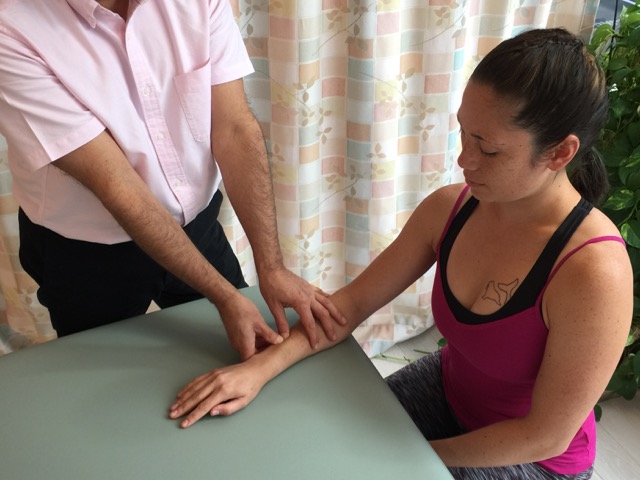Manual therapy treatment for De Quervain’s Syndrome:
Once present, De Quervain’s syndrome (De Quervain’s disease) can be challenging to resolve, but manual therapy treatment can be very beneficial. As an inflammatory condition, icing is critically important. Given the presence of stenotic adhesions within the tendon sheath, cross fiber massage work at the distal tendons and their synovial sheath are also important. If the area is very tender to touch, icing can be done before soft tissue work to minimize client/patient discomfort and allow for deeper work. It can also be extremely beneficial to ice the client/patient directly after deeper pressure is used to minimize any inflammatory reaction to the work. Of course, before any deeper work is done, it is always important to warm up the region of the client/patient with gentler work first, gradually transitioning toward deeper pressure techniques.

Cross fiber massage to the posterior forearm (abductor pollicis longus and extensor pollicis brevis) to treat De Quervain’s Syndrome. Permission: Joseph E. Muscolino.
And, given that tightness of the bellies of the abductor pollicis longus (APL) and extensor pollicis brevis (EPB) will continue to place a tensile force on the tendons, it is important to work their muscle bellies with manual (massage) therapy. They might be deep to the superficial wrist and finger extensors of the posterior forearm, but when tight, they are usually readily palpable and easily worked with moderate to deep pressure massage. Manual therapy work on the bellies can be done in any direction. A combination of longitudinal work, circular friction, and cross fiber works nicely, with cross fiber becoming the primary stroke as the bellies transition to tendons. As the condition is beginning to resolve, stretching of the APL and EPB can also be done; pin and stretch is especially effective when working these muscles.
However, given how difficult it is to avoid use of the thumb, De Quervain’s syndrome is easily exacerbated and usually takes many months to resolve, if not fully, then sufficiently so that the client/patient can function without pain. Therefore, client/patient compliance with self-care recommendations is critically important.
Once direct care to the radial side of the wrist and bellies of the APL and EPB has been done, it is wise to work the entire upper quadrant on that side. Begin at the neck, and work your way down into the upper back, shoulder region, arm, anterior forearm, and hand, including joint mobilization of the carpal bones. Although these regions are not directly responsible for De Quervain’s syndrome, they may be involved in dysfunctional postural and movement patterns that contribute to the condition.
Summary of Manual Treatment Protocol for De Quervain’s Syndrome
| 1. Fascial spreading strokes to the forearm, hand, and thumb |
| 2. Longitudinal, circular and cross fiber strokes to the APL and EPB bellies |
| 3. Cross fiber work to the APL and EPB distal tendons |
| 4. Pin and stretch to the APL and EPB |
| 5. Ice the APL/EPB tendon sheath |
| 6. Joint mobilization of the carpals |
| 7. Work entire upper quadrant on that side |
Precautions/contraindications when treating De Quervain’s Syndrome:
When working with a client who has De Quervain’s Syndrome and working the radial side of the wrist, avoid placing deeper pressure over the anatomic snuffbox (between the distal tendons of the APL/EPB and extensor pollicis longus) because the radial artery, a branch of the radial nerve, and the cephalic vein are superficial here and sensitive to pressure.


